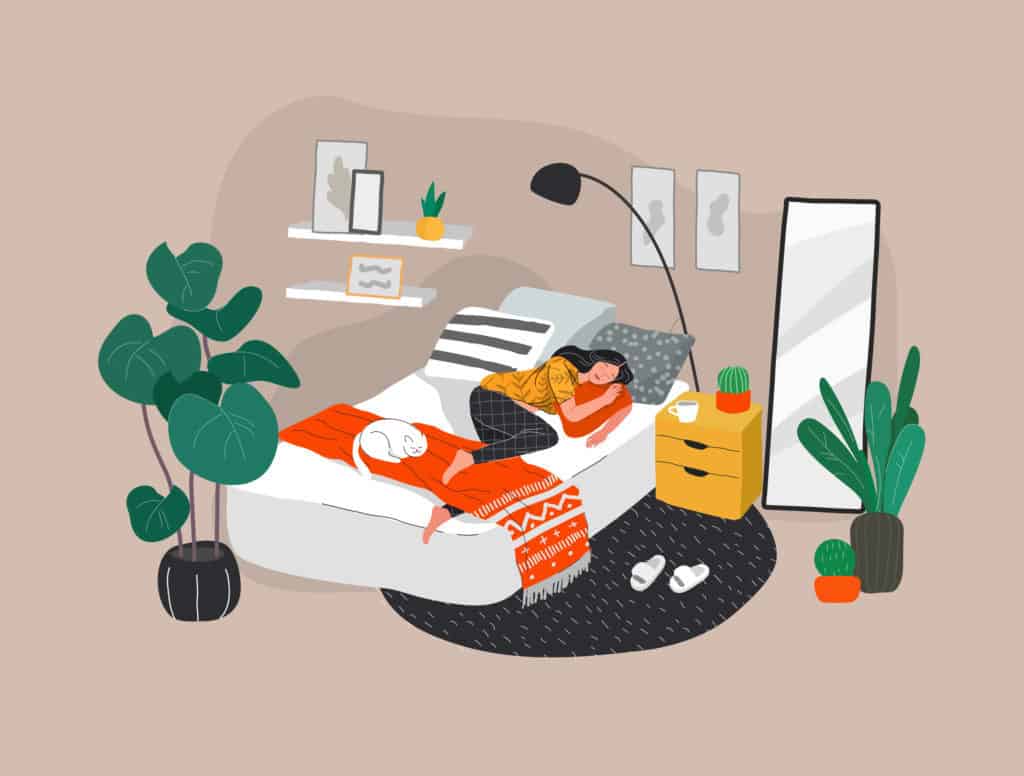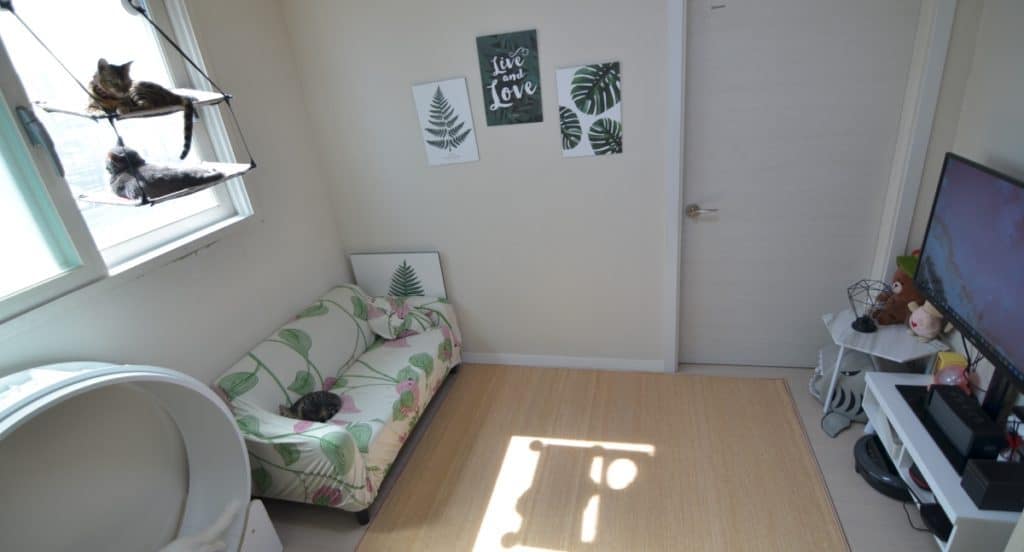Whatever your conditions are, there are times when we have to either keep our cats in one place for their safety or simply if there just isn’t enough space. For example, in certain places in the world, it’s very common for people to live in one-room apartments with their pets.
Many people think it’s cruel to keep their cats in one room but it’s most of the time it’s crueler to keep cats outside where there are a lot of risks, disease, and danger.
So is it possible to keep cats in one room? Keeping cats in one room is very possible if it’s at least 15 square meters and as long as there are adequate amounts of elevated areas for the cats to escape to if necessary. Keeping cats in a small space means that should be more stimulation in their environment (proper furniture) and more playtime to compensate for the lack of space.
How small is too small? Read more about how big your room or apartment should be to have a cat: Is Your Apartment Big Enough for a Cat or Multiple Cats?
Of course, there are a lot of factors but as long as owners understand the needs and requirements of their cats, they will be more than satisfied.
Here is how to keep a cat in one room:
- Make sure that they have their basic requirements met (meaning physical requirements).
- Then make them stay in that room of their own choice by fulfilling their instinctual requirements and emotional requirements!

As mentioned before, I live in a small studio apartment right now and use to live in an even smaller studio apartment with my cats (4 at this point). I go to work in the morning and come back in the evening like many people and when I come home, the cats greet me and they’re very affectionate. So take it from me, it’s very possible.
Room Essentials For A Cat
So if we start to think about what a cat needs to feel stimulated and satisfied, it’s really not all that complicated (so don’t feel bad or guilty!) (so don’t feel bad or guilty!). Cats need all of these things to prevent negative behavioral or health issues. Some of these being obesity, destructive behavior, lethargic behavior, and even aggressive behavior towards you or your other animals.
Physical Essentials
- Food
- Water
- Litter Box
These are straightforward. Cats need food, water, and a litter box to relieve themselves. A lot of people think that this is the end all be all of owning a cat and unfortunately they quickly realize that there’s more to it.
This is the starting point but it’s easy to build off of this to create an environment in one room that can satisfy more than just a cat’s physical essentials.
Instinctual Essentials
- Proper scratching post
- Elevated surfaces and vertical space (*Bonus, place to perch on the window)
- Play-time

Now let’s think about what a cat needs to do to feel like they’re cats. Cats are hunters and hunters have their weapon of choice and for cats, of course, it’s their claws. A cat will find the sturdiest, tallest, and most resistant thing in your bedroom to be a claw sharpener, so unless you have a proper cat scratcher such as the ultimate scratching post, they will find other things to scratch (usually things we don’t want it to scratch). So provide them with a good scratching post.
The next thing to tackle is their hunting instincts. When I lived in a one-room apartment with my cats, I had to play with them every night before I slept. Why? Because they wouldn’t let me sleep otherwise. A good play session with your cats is the difference between a well-adjusted cat and a demon cat. Read more about the importance of play and how it affects your cats.
One thing to note is that the type of play is important as well. Cats love to hunt so use something that allows them to chase, climb, or burrow. Interactive wand toys and fetch will allow them to do these types of things while things like a stationary toy that they bat around can easily get boring.
The amount you need to play with your cat will be dependent on how active your cat is. I recommend at least once per day in the beginning and then when they get used to the schedule, once every two days will be enough to satisfy them. This may also depend on if you have more than one cat. The main point to get across is that play is essential. For more details on when the most optimal time to play with your cat, read about it here!
The last thing to touch upon is their territorial instincts. We also have to remember that in the wild cats are also prey to larger animals. Therefore, they feel the safest when they are in high places.
Allow them to get away from danger or uncomfortable situations by giving them these spaces so that other rooms aren’t necessary. A good way to provide this is with window hammocks or other types of platforms. Read more here about how to provide these types of places for our cats!
Emotional Essentials
- Cat – human interactions
- Having a schedule for play and meals
- * Bonus cat to cat interactions (not essential but recommended)
What’s the point of owning any pet if we are not going to be interacting with them? Or allowing them to interact with us? Every living thing wants attention and as the owner, being social and involved with your cat is important for its emotional development.
Having a schedule and a routine for you to interact with your cats is integral for your bond with your cats. Cats are habitual creatures and as they recognize that you are involved with their daily lives, they are able to create those bonds with you.
Other than creating bonds, having a hectic or frequently changing household environment can be very stressful for certain cats. This increase in stress and stress hormones caused the cats to be twice as likely to be ill or sick in recent studies.
While many people might only want one cat in their lives, I believe that cats are innately quite social and love the extra company by another cat friend. Being able to do things together and even just being in each other’s presence is great for the mental health of your cat. Not only that, it allows you some breathing room so that you don’t have to plan everything around your cat if you have a very active breed (such as my Bengal).
Preparations and Things to Avoid When Living With a Cat in One Room

- Clutter – the first thing to avoid is clutter. Being highly organized and neat is one of the main ways to get your cats out of trouble and to keep you sane. It also teaches your cat what is acceptable or unacceptable to play with.
- Cables – get cables under control. For the same reason as above, young cats if allowed to bite cables, will continue to bite cables as they grow up. Not only will it destroy your items, but it’s also dangerous for your cats for obvious reasons.
- Unders – A word that cat people invented to call the space under your bed, couch, and other small spots underneath. For cleaning, they are terrible for cleaning and organizing because it’s a pain to get everything under there and somehow cat hair always ends up collecting there. Unders also prevent cats from going out of their comfort zone (if they’re a new in the household), so it might complicate introductions in a multi-cat home.
Other Recommendations For Cats in One Room
These are the things that I want to recommend quickly but are not mandatory. They just help with either convenience or better for sanitary/safety reasons. If you want or have the time, you can read more about these topics following these links:
- Use pine litter
- Keep cats off of the ground
- Invest in an air purifier and robotic vacuum for cat hair/shedding management
When Keeping Your Cats in One Room Wouldn’t Work
If you are keeping your cats in one room just because you want to hide them for some reason or can’t pay attention to them for longer than a day, it’s best to avoid having any animals in general. Like any living thing, they crave attention and want to socialize.
With prolonged neglect or lack of interaction, indoor cats can become more stray-like and return to a more fearful state, resulting in distrust and aggression. Therefore, if this is the situation that you might be in, it’s best to avoid having cats until you’re ready to take responsibility to satisfy these requirements!
Final Thoughts
Those that are considering having a cat in their place and are concerned about a small living space, be assured it’s entirely possible to give our furry felines a stimulating and fulfilled life!
Are your cats living in a single room, or a in a small space? Share your experiences or ask any questions down in the comments section.

Hi I’m going to get a gorgeous ragdoll kitten I. 5 weeks time she will be 12 weeks old. I’m preparing for where I will place things but can’t decide where to put the litter box. Unfortunately my entrance by the front door is very narrow and small my only options are bedroom or front room. What do you recommend? I’d like to ideally avoid smells leaching into things in that particular room.
Thank you!
Natalie
I would think about where the cat will spend the most time and where the is a good amount of ventilation. Remember to avoid facing the litter box entrance towards a door and keep the area uncluttered! In your situation, with 2 rooms, I would prefer for the litter box to be in the front room and some sort of cat furniture (such as a scratching post) in the bedroom. Cats like to have different scent “markers” in different rooms.
Hope this helps!
Two months ago, I rescued an 8-week old kitten and decided to adopt it. At first, my family agreed to adopt it thinking that it will be an outdoor cat. As I invested time and effort in learning about cat care, I decided that I would like to keep her indoors and adopt another kitten as her friend. I adopted a second kitten and they are getting along very well. My mother is allergic to cats, so I decided to keep my cats in a 60 square meter room that we do not use. It has lots of windows. A few times a day, I play with my cats in our backyard with grass and trees. I supervise their outdoor time. But still, I get worried if it is not right to keep them in just one big room. I’m planning to add elevated shelves and hammocks in the window. I visit my cats three times a day and spend about an hour per visit since I work at home. Do you think my cats would feel they are isolated and get sad?
I think as long as you give them attention daily, I don’t find any problem with this. 60 square meters is quite a bit larger than my apartment and can be a great environment for them if you catify it!
I have 5 cats. 1 was found at a week old. He’s indoors with me. The other 4 are feral; 1 extreme. Him, I have been feeding for 9 years. He brought a girl home and we bonded but she is his company and they are bonded. 1 other I’ve been feeding here and there for about 3 years and the other a baby who started coming to eat last fall. I moved, trapped all 4 and they are all with me. 3 I have been able to socialize. I can’t keep them in my house because they do not all get along Two and two are together while I prep for them. I’ve been building 2 rooms in my heated/air conditioned garage. Each is 8×8 with a window and 10 ft ceiling We are building up the walls for climbing and making it look like a living room. Once done they will also have a catio to be able to safely go outdoors. Do you have any suggestions?
Hello! Thank you so much for your content. I hope you can help me with my situation. I have two male cats who have lived together for a good number of years. They are both neutered and get along great. Some time ago I noticed a tuxie male cat around our apt complex. It has been a couple of years of seeing him roaming i decided to leave it some food in the patio and made it a shelter for some of the cold weather. Long story short, he now sees that balcony as home and it took months but i have finally got him comfortable with me to the point that i can pet him and play with him. On really cold days he wants to come inside the apt (1 bedroom) and will cry and cry until I let him in. I let him in to see how my other cats would react and unfortunately they both reacted very aggressive towards the new cat. They immediately go and attack him. One will howl loudly and attack while the other stares quietly but eventually attacks. What surprises me is the the new cat, feral as he is, is very kind to my two cats. He only defends himself, mainly allowing himself to get beat up. He will sit in a little corner and mind his business not wanting to intrude or intimidate the two cats. Regardless of his gentle nature and his wanting to play and get along, my two cats still try and attack him. I saw one of your videos and have followed your steps but one thing stands out and i think it may be the problem. The new cat is not neutered to my knowledge. Is it safe for me to assume that until he is neutered, it will not matter how gentle and nonaggressive he is, he will be attacked constantly by my two cats or can neutered cats and a non-neutered cat get along eventually? I appreciate any help you can provide me. Thank you!